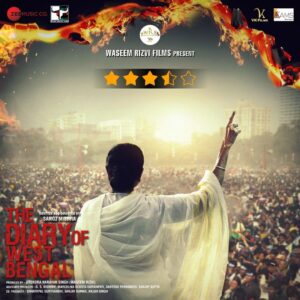
Title: The Diary of West Bengal
Director: Sanoj Mishra
Cast: Yajur Marwah, Arshin Mehta, Reena Bhattacharya, Dr. Ramendra Chakarwarti, Gauri Shankar, Reena Bhattacharya
Where: In Theatres
Rating: ***1/2
‘The Diary of West Bengal’, written and directed by Sanoj Mishra, plunges the audience into the turbulent and tragic events of the 1971 Bangladesh genocide. The film’s opening sequence is a harrowing as it dives into the horrors of that time. We witness the brutal slaughter of Suhasini Bhattacharya’s (Arshin Mehta) family. The scene is raw, visceral, and designed to shake viewers to their core—a stark reminder that history’s wounds are not easily forgotten.
The Road to Survival
Suhasini’s journey begins in the blood-soaked streets of Bangladesh, but her quest for survival leads her across the border into India. Expecting sanctuary, she finds herself in the tangled and treacherous web of political machinations instead. The Sunderban jungles provide a fittingly bleak backdrop for Suhasini’s initial attempts to find refuge. Here, she encounters Prateek (Yajur Marwa), a seemingly kind author who offers her hope—a commodity in short supply in her world. But as the film unfolds, Suhasini learns that hope often comes with strings attached.
Subtle Yet Stark Themes
As Prateek’s true intentions are slowly revealed, the film touches on the controversial subject of “love jihad,” subtly woven into the narrative. This element adds a layer of complexity to Suhasini’s story, portraying her as a victim not just of political forces but also of personal betrayal. The film doesn’t shy away from these themes, instead embracing them with a boldness that is sure to spark conversation.
The Political Chessboard
The film also delves into the exploitation of foreign nationals as political pawns. Suhasini’s journey takes her to Kolkata, where she witnesses the manipulation of vote banks and the calculated moves of politicians who see people like her as mere numbers on a ballot sheet. In the climax, Suhasini breaks the fourth wall, directly addressing the audience with the provocative question: “Why is there a decline in the Hindu population in the neighboring non-Hindu countries?” This moment is designed to jar viewers out of passive observation and into active reflection, underscoring the film’s broader social commentary.
Cinematic Craftsmanship
On a technical level, the film excels in its execution. The cinematography by Satyapal Singh captures the raw beauty and harsh reality of the landscapes, from the dense, foreboding jungles to the chaotic streets of Kolkata and other parts of West Bengal. Singh’s lens doesn’t flinch away from the brutality of the story, instead framing it with a realism that makes the horror all the more palpable.
The sound design further enhances the film’s impact, immersing viewers in its cinematic universe. The haunting score by A.R. Datta, combined with lyrics by Kundan Vidyarthi and Sameer Shashtri, serves as an emotional anchor throughout the film, reinforcing the themes of loss, despair, and the flickering hope that keeps Suhasini moving forward.
Performances Anchored in Reality
Arshin Mehta delivers a compelling performance as Suhasini, embodying the character’s blend of vulnerability and determination. Her portrayal is the heart of the film, grounding the sometimes overwhelming narrative in a personal story that audiences can connect with. Yajur Marwa’s Prateek is equally effective, his charm hiding a darker, more manipulative side that slowly comes to light. The supporting cast, including Dr. Ramendra Chakrabarti, Gauri Shankar and Reena Bhattacharya, provide solid performances that add depth to the film’s ensemble.
Conclusion: A Bold Statement
This film, presented by Waseem Rizvi Films, is not for the faint of heart. It is a bold statement on contemporary socio-political issues, wrapped in a narrative that refuses to pull its punches. While the film’s heavy-handed approach might not appeal to everyone, there is no denying its intent to provoke thought and discussion.
Overall, the film is a cinematic experience that demands attention. Whether or not you agree with its perspective, the film forces you to confront uncomfortable truths and leaves you with questions that linger long after the credits roll. As such, it stands as a powerful piece of filmmaking, one that refuses to let its audience remain passive observers.



